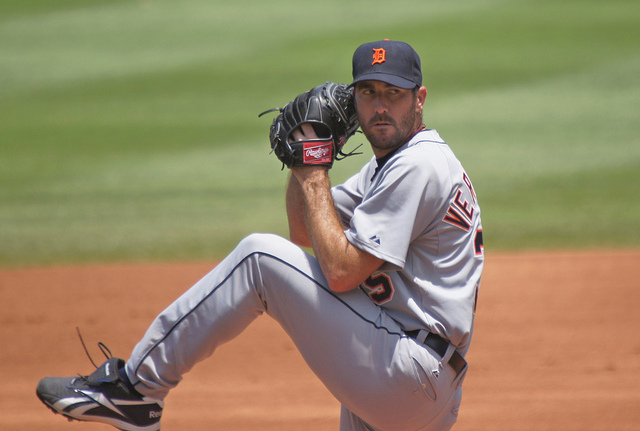2013 Fantasy Baseball: Buy Justin Verlander, It Will be Worth It


Just before the 2013 season kicked off, the Detroit Tigers made a very large investment in Justin Verlander. And if you happened to acquire the Tigers’ ace for your fantasy team, then it’s safe to assume that you also made a very large investment. Through May 6th, it seemed like the Tigers and fantasy owners were going to get their money’s worth. Verlander held a 1.55 ERA and was dominating hitters like in seasons past. But now it’s one month later, and owners may be starting to feel a bit shortchanged.
[am4show have=’p3;p4;p7;’ guest_error=’Front Office’ ]
The right hander’s ERA and WHIP ballooned to 3.70 and 1.36, respectively. He has given up more hits than innings pitched. And there is concern about his velocity. This is not what big investors of Verlander want to see.
When we look at great players who are delivering poor results, the first thing we consider is misfortune. Could this all be attributed to bad luck? Possibly. But what about Verlander’s decreased velocity? Let’s break it all down starting with his batted ball profile, as well as his swing and contact rates.
Here is a chart of Verlander’s batted ball profile:
|
Season |
Team |
GB/FB | LD% | GB% | FB% | IFFB% | HR/FB |
| 2012 | Tigers |
1.19 |
22.2 % |
42.3 % |
35.6 % |
15.4 % |
8.3 % |
| 2013 | Tigers |
1.34 |
25.0 % |
43.0 % |
32.0 % |
14.1 % |
7.8 % |
| Career | – – – |
1.03 |
20.2 % |
40.5 % |
39.4 % |
11.3 % |
7.9 % |
*Data collected from Fangraphs
And a chart of Verlander’s Pitch F/X plate discipline:
|
Season |
Team |
O-Swing% | Z-Swing% | Swing% | O-Contact% | Z-Contact% | Contact% | Zone% |
| 2012 | Tigers |
32.4 % |
65.3 % |
49.4 % |
64.4 % |
80.9 % |
75.7 % |
51.9 % |
| 2013 | Tigers |
31.0 % |
64.2 % |
47.9 % |
60.8 % |
82.7 % |
75.7 % |
50.8 % |
| Career | – – – |
31.4 % |
62.8 % |
47.7 % |
65.9 % |
84.0 % |
78.3 % |
51.9 % |
*Data collected from Fangraphs
There are a few metrics that aren’t noted in these charts. Verlander’s pitch usage is relatively the same from last season. His first pitch strike percentage is up compared to last season, and his career, sitting at 63.1%. His swinging strike rate is at 11.5%, which is higher than his career rate, and is in line with last season. This goes along with his ridiculous 27.9 strikeout percentage, which if holds, would be a career high.
When reading through these metrics, there is only one real issue that stands out, and that is Verlander’s line drive percentage. Everything else is about in line with his normal rates. His LD% is below average for the league, and for him. His zone contact percentage is also up a bit, but less than his career norm. The LD% isn’t great, but there isn’t anything here that should bend anyone out of shape.
You can also look at Verlander’s BABIP (.359 compared to a career mark of .287), his xFIP (2.96), and his SIERA (3.08), and assume that he has merely been unlucky. Not to mention the Tiger’s dreadful defense doing him no favors. But what about that velocity issue?
Verlander is only averaging 92.5MPH on his fastball. That is down two MPH from last season and down three MPH since 2009. Should we be concerned with a 30 year old pitcher, who averaged about 240 innings the last 4 seasons (not including playoffs), that has a significant decrease in velocity? Perhaps. Or perhaps not yet.
According to Brooksbaseball.net, Verlander’s velocity is actually increasing. Since May 11th, his average fastball is 93.78MPH. This is much closer to his 2012 fastball velocity that averaged out at 94.3MPH. That is very promising. However, when you look at Verlander’s zone percentage, there is a surprising trend.

*Data and image from baseballheatmaps.com
According to this graph, Verlander has shown a decrease in Zone% since about the middle of April. There are some rises, but overall, there is a steady decline. I looked through Verlander’s release point charts from 2009 to the present. They haven’t really changed. Even in the starts where he pitched poorly, his release point basically held true. Verlander’s late game consistency with his delivery (data provided by baseballheatmaps.com) also looks fine. His release point consistency isn’t the problem. And if my words don’t convince you that Verlander is a pitching machine, check this out.
Taking into account his performance (past and present), including his strong first pitch strike percentage and his consistent release point, you have to believe that Verlander’s Zone% trend will reverse course soon enough. And although his BB% is up from the past two seasons, it isn’t out of control.
As for being concerned about a potential injury, it is always difficult to predict. Certain things may worry you. But overall, when you watch Verlander pitch, the metrics, and the trends, I don’t believe there is enough evidence to say that he is on the verge of having an injury in 2013.
Right now, Justin Verlander has an ERA and WHIP that suggests he’s struggling. And when a pitcher shows a significant velocity decrease, many assume the worst. But when you consider the recent velocity gains and that his metrics are looking positive, now would be the time to steal Verlander away from a worried owner. Assuming he reverses that Zone% trend, to go along with some justified good luck, Justin Verlander should soon return to being a Cy Young candidate and be worth every penny.
Thanks to Fangraphs.com, Brooksbaseball.net, and Baseballheatmaps.com for the data.
Thanks to blessyouboys.com (SB Nation) for the GIF.
[/am4show]





